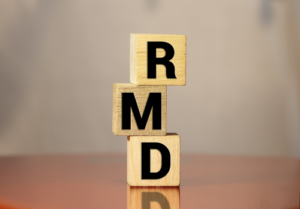You've probably heard that OBBA eliminates taxes on tips and overtime pay. Here's what you need to know about how this is expected to work:…
 The rules regarding required minimum distributions (RMDs) have been somewhat flexible over the past few years due to the pandemic as well as SECURE Act 2.0 which passed at the end of 2022. Here’s some recent guidance and clarification from the IRS that affects account owners whose first RMD was in 2023:
The rules regarding required minimum distributions (RMDs) have been somewhat flexible over the past few years due to the pandemic as well as SECURE Act 2.0 which passed at the end of 2022. Here’s some recent guidance and clarification from the IRS that affects account owners whose first RMD was in 2023:
First, some background info . . .
Traditional (i.e., not Roth) IRA and 401(k) accounts allow tax-deferred contributions. These contributions are not subject to federal (and generally not state) income taxes at the time the contributions are made, but at some point Uncle Sam wants his money.
That’s where required minimum distributions (RMDs) come in. RMDs must be withdrawn from retirement accounts by a specific date, called the “required beginning date”. The amount of these distributions is calculated based on the life expectancy of the account owner as of the required beginning date and are recalculated each year.
The required beginning date is April 1 of the year following the year in which the account owner attains the applicable age (see below).
Once the account owner has taken the first distribution by the required beginning date, RMDs must be withdrawn by December 31 of each calendar year. That means that if you wait until April 1 of the year after you reach the applicable age to take your first RMD (calculated based on your age in the prior year), you will have a second RMD due by December 31 of that same year calculated based on your attained age in that year.
RMDs are fully taxable and are not eligible to be rolled over into another retirement account in order to maintain their tax-deferred status.
What’s the applicable age?
Legislative changes over the past few years have made the applicable age and the required beginning date somewhat of a moving target.
If you’re the account owner of an IRA and you turned 72 in 2022, the required beginning date for your first RMD was April 1, 2023. Makes sense, right?
But at the end of 2022, SECURE 2.0 was signed, moving the applicable age from 72 to 73 effective January 1, 2023. So if you were born in 1951, you turn 72 in 2023, but you’re not subject to the RMD rules until you turn 73 in 2024, making your required beginning date April 1, 2025.
(Due to quirky timing, if you turned 73 in 2023, you were 72 in 2022 and subject to the age 72 RMD rule in effect in 2022. That means that nobody has a required beginning date of April 1, 2024.
And in case you’re keeping track, the applicable age is set to increase to age 75 by 2033. At least under current law, which is always subject to change.
Questions?
Everyone’s situation is different, so if you have questions about how this affects you, contact your investment advisor or Kindred tax professional.



